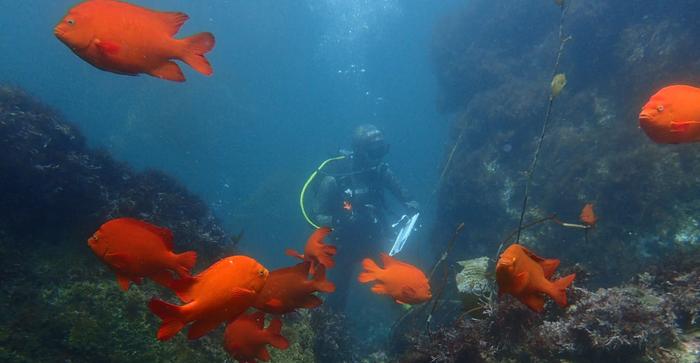Marine Protected Areas (MPAs) have become essential tools for the conservation of ocean ecosystems, safeguarding marine life while balancing human activity and biodiversity. As scientific understanding of these areas has evolved over the past few decades, researchers have increasingly focused on determining the effectiveness of MPAs in promoting not just the protection of marine habitats, but also the recovery of fish populations and their ecosystems. In a groundbreaking study led by scientists from the University of California, Santa Barbara, an extensive evaluation of California’s marine protected area network has yielded positive insights into the tangible benefits of these ocean sanctuaries.
Back in 1999, California became a pioneer in marine conservation when it established a comprehensive network of MPAs. The Marine Life Protection Act (MLPA) mandated the state to design a system that would effectively conserve marine ecosystems without imposing broad restrictions on ocean usage. This innovative approach involved creating a series of smaller protected areas, rather than closing off vast sections of the ocean. These MPAs were carefully configured to enhance connectivity among marine life, allowing the flow of nutrients, plankton, and the migration of fish populations.
Fast forward to the present, researchers now have over two decades of data to analyze the outcomes of the 124 MPAs established through the MLPA. The recent study highlights the importance of these areas not just in protecting individual species, but also in restoring the overall health of marine ecosystems. The team, led by Joshua Smith, aimed to answer the critical question: Do MPAs actually work? Through rigorous data analysis, they confirmed that many MPAs do indeed contribute positively to marine biodiversity, particularly for fish populations targeted by fisheries.
The findings of this study suggest that older MPAs tend to show significant increases in fish biomass, especially in species like rockfishes that have been emphasized in fisheries management. The data revealed a clear correlation between stringent protective measures and increased fish populations, indicating that when fishing pressures are reduced, marine life can thrive. This has crucial implications as global initiatives now strive to protect larger sections of the ocean and as marine protection efforts gain momentum.
Central to the success of these MPAs is habitat diversity. Locations incorporating a variety of habitats—such as kelp forests, rocky reefs, and soft-bottom areas—provide essential resources for marine life, contributing to healthier fish populations. The research emphasizes that fish often utilize multiple habitats at different stages of their lives, so ensuring that diverse habitats coexist within an MPA maximizes the chances of long-term sustainability and resilience of marine communities.
An interesting aspect of the study is that it revealed the temporal nature of benefits associated with MPAs. Researchers noted that many fish species in California are slow-growing and take considerable time to mature. Thus, the conservation strategies established through the MLPA required patience before revealing their full impacts. This insight reiterates the necessity of long-term monitoring and assessment, reinforcing the idea that conservation measures must be maintained over the years to achieve meaningful biodiversity gains.
In a collaborative effort, the team of 24 scientists pooled data from various monitoring projects across California’s coastline. They evaluated the conservation performance of 59 MPAs, focusing on metrics such as species abundance and biomass. By synthesizing data collected through different methodologies, the team could conduct a comprehensive analysis of marine life both inside and outside these protected areas, ultimately allowing for more informed management decisions in MPA design.
Moreover, the research advocates for continued investment in marine monitoring initiatives. Attaining a thorough understanding of how different MPAs across California function allows scientists and policymakers to adapt and refine conservation approaches based on empirical evidence. This research not only celebrates California’s successes but also sets a standard for marine conservation efforts globally. The study illustrates that well-planned MPAs can yield considerable benefits, fostering resilience and productivity in marine environments.
The findings presented by Smith and his colleagues provide reassurance and validation for the extensive efforts that have shaped California’s marine protection journey. As more countries consider or implement MPAs, they can draw on insights from this long-term research to design networks that are not only effective but also sustainable, addressing both ecological and economic needs. The success seen in California provides a hopeful message: when rightly structured and managed, MPAs can bolster marine biodiversity and enhance the productivity of fish stocks that local communities depend upon.
In summary, the insights gleaned from the study showcase the capacity of MPAs to foster healthier ocean ecosystems while also supporting the fishing industry. The enduring commitment to marine conservation in California serves as an exemplar for global conservation initiatives aimed at ensuring the vitality of marine ecosystems. Ultimately, as humanity seeks to understand and mitigate the impacts of human activity on marine life, the success of programs like California’s MPAs will be invaluable in guiding future endeavors.
Subject of Research: Conservation benefits of California’s marine protected area network
Article Title: Conservation benefits of a large marine protected area network that spans multiple ecosystems
News Publication Date: 9-Jan-2025
Web References:
References:
Image Credits: Credit: Jennifer Caselle
Keywords: Marine conservation, marine protected areas, California, biodiversity, ecosystem management, fisheries management, conservation biology, marine ecosystems, ecological resilience.




